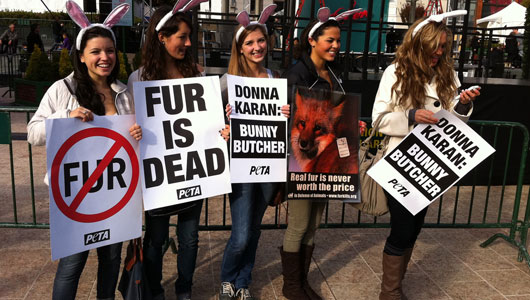
For the first time in this country’s history, the Californian city of West Hollywood has banned the sale of fur, in keeping with its tradition of upholding the values of animals and their wellbeing. Though city council members passed the law by unanimous vote two years ago, it finally went into effect ast week year on Sept. 21.
The development came days after the city passed an ordinance banning all entertainment acts, including circuses, that use wild or exotic animals, making this a twin victory for animal rights supporters and activists.
It follows a history of pro-animal legislation in West Hollywood, including the banning of steel-jaw traps and cosmetic testing on animals in 1989; the banning of cat de-clawing in 2003; and the banning of the retail sale of cats and dogs in 2010, which pushed people to adopt from animal shelters instead. It seems that the city is well on its way toward achieving its purported mission of becoming “the Humane Capitol of the Nation.”
Retail stores will have to clear fur products off their shelves by Sept. 28 or face $800 fines. Predictably, many are decrying the ordinance, with Mayfair House, a specialty clothing store on Beverly Blvd., going as far as to claim it is “unconstitutional.” Store owner Johanna Judah thought the ordinance was “ill-considered … and harmful to the city and its consumer citizens and business residents,” as well as a supposed attempt by animal rights activists to “impose their will over others.”
Mayor pro tempore John D’Amico argued that there is no ethical way to produce fur, and that the ban will ultimately not harm businesses. “This city is not in the business of curtailing businesses,” he said. “Someone who is disconnected from the goals of the city and has a rigid point of view on fur” may not understand that.
Some business owners, however, do understand, and support the ban. One of them is David Malvaney, cofounder of Church Boutique, an avant-garde fashion shop. “We are on board with the ban,” he said, “as we understand the concerns and have realized there are many other fabrics and fibers that can easily take the place of real fur. We feel that the desire for real fur will lessen over time as more people become aware of the process to which the animals are subjected, and I believe more cities will adopt a similar ordinance.”
That “process” is usually the outright murder of innocent animals. In fact, statements like those of the Mayfair House calling the fur ban “wrong” might seem perverse in the eyes of some, given the fact that the fashion industry’s fur trade causes over 50 million animal deaths per year. (The Humane Society of the United States has composed a list of fur-free retailers, designers, and brands for conscientious shoppers to peruse.)
For Mayfair’s part, they are currently filing a lawsuit to try and overturn the ban.
Lindsay Rajt, associate director of campaigns for PETA, commented, “It’s up to individual cities and consumers to end this cruelty. West Hollywood is setting another tremendous example for cities to follow.”
City spokeswoman Tamara White added, “We’ve consistently worked to enact cutting-edge animal welfare legislation. This is in line with our values.”
Animal rights activist and West Hollywood resident Ed Buck said the ordinance is a “huge success for the national drive toward fur consciousness-raising. This is monumental.” The debate is over, he concluded. We know that fur sales are inhumane. “Compassion is the fashion,” he declared. “You do not need to sacrifice an animal to be fashionable.”
Photo: An anti-fur demonstration in West Hollywood. Flickr










